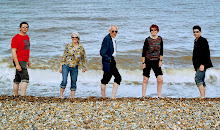On the spur of the moment, we went to the performance of Gesualdo's
Tenebrae in Trinity Hall Chapel, where de Waal's installation
Tenebrae sat in a row on the floor down the aisle, up at the holy end. It consisted of a number of large, shallow pots somewhat larger than dinner plates, about 3 or 4 inches deep, and in each sat what looked like an inverted cylinder, almost filling the interior. Down the insides, like the gap between a boat and the dock, you could just glimpse the fact that the bottom of the larger piece was coloured, but not what the colour was, beyond its darkness. The pieces difffered slightly in size and proportion, and in glaze, but they had more in common than not. I didn't know what to make of them, really - they were mute, and from where I was sitting during the performance I couldn't see them. But I could imagine them, with the sound of the voices falling into them, and the shadows darkening, while they harboured their own secrets in their interior.
I hadn't been in TH chapel before. It's small and rather lovely in an 18thC way. A huge sub-Poussinesque altarpiece, lots of natural light, lots of oak, and a pretty gallery. There were, J told me, 26 candles, and these supplied the majority of light as day began to fade.
And having done no homework about the music, and having been kept away from churches in my childhood, I didn't know about the
religious service, though something of its nature became clear through the music itself, and the odd snatches of Latin I was able to recognise. So my experience of the installation and the performance was not well-informed, and I was reacting on a fairly visceral level.
It was perhaps a strange time of year to be singing
Tenebrae or celebrating the Passion. The music wasn't a piece I knew, and I had misgivings about its discordances - it wasn't clear if they were Gesualdo's or something incidental. Yet no-one else seemed disconcerted. It was rather long, too, though this only bothered me when I thought someone was off-key. It became clear that the piece was deliberately timed to start in daylight and end in total darkness. It was certainly an experience watching the candles come into their own. Afterwards, everyone milled around and looked at the pots in - it has to be said - a somewhat cursory fashion, as there were about 60 of us - and then afterwards to the Master's Lodge for a glass of wine and a chance to meet the great man himself.
Fourteen pots, I counted.
The Master's Lodge! Oh, I could live like that! And there was a de Waal on a window ledge: two huge cylinders like those tube-worms that live near underwater volcanic vents... tall and thin, and swaying slightly in unison. They were almost identical, but one had a very shiny glaze and the other silkier. From across the room, you could tell instantly they were de Waal's.
There was a lull when de W was standing by himself, so I told him how much we'd enjoyed the exhibition in the gallery, the subtleties, the wit, and the way he withheld things - how we'd nearly missed 'All You Can See' (the red shelf piece) and he was amused and touched, I think. (It was more of a conversation than I'm making it sound.) And he said how he'd always longed to do an installation in the chapel. I should have asked him about the spiritual dimension, and his asceticism. I wanted to ask him about Morandi too, but more people came up then to talk to him.
J was edgy throughout (his seat was uncomfortable, and it's not his sort of art or music anyway) but even so we came away, as we usually do from such events, with a sense that we are enormously privileged.
Still thinking about it later. I cannot know how differently I'd have experienced the evening if I'd known something about it at the outset, if I'd bothered to do the slightest research rather than just looking at my watch and saying:
it starts in half an hour - we can catch it if we leave right now! without a sense of what 'it' really was. A concert, we thought. I doubt I'd have persuaded J to come with me otherwise.
Fourteen pots. Fourteen Stations of the Cross. I should have realised. Yet it's a curiously flattened interpretation of the Passion, even allowing for what's concealed. Then again, it fits with the stripping down of the altar that traditionally accompanies the service. We couldn't have counted them from where we were sitting, so it can only affect the experience retrospectively. And retrospectively, I wonder if I'd have felt the pots, lovely and mysterious as they are, equal to their metaphorical burden, if I'd been thinking clearly about the religious meaning. It was a very secular audience - the couple next to me were the only ones who didn't applaud. I'm bothered, really, by treating something like that as a purely aesthetic experience, even though I can't partake of the spiritual side of it. It's cultural tourism, isn't it? I wish I'd got my mind engaged before I went - we left in a rush, and didn't think about it as more than listening to some music. Is it simplistic to hope that music, art, will create its own conditions for attending to it?
Oh, and apparently Gesualdo was a
murderer.





